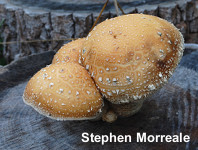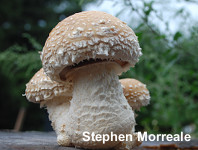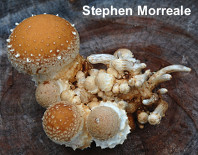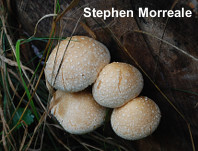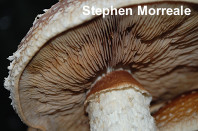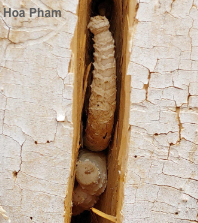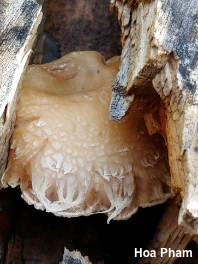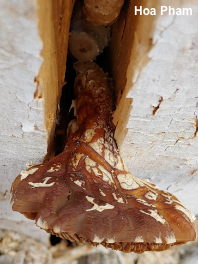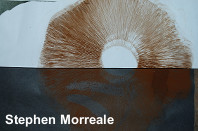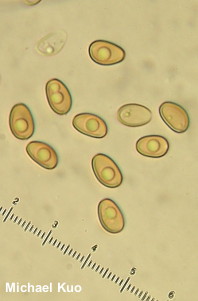| Major Groups > Gilled Mushrooms > Dark-Spored > Pholiota > Hemipholiota populnea |

|
Hemipholiota populnea [ Basidiomycota > Agaricales > Strophariaceae > Hemipholiota . . . ] by Michael Kuo Widely distributed wherever cottonwoods occur, this distinctive species helps decompose the deadwood of cottonwoods, often appearing on cut surfaces of cottonwood logs. The cap and stem are both shaggy with soft, cottony scales; the gills are narrowly attached to the stem; the spore print is cinnamon brown; and the mushroom is generally robust in stature. Hemipholiota populnea probably appears in your field guide as "Pholiota destruens." However, that species has been synonymized with Pholiota populnea (see, for example, Noordeloos 1999)—and contemporary DNA-based study (Jacobssen & Larsson 2007) supports the idea that the species belongs in the genus Hemipholiota, more closely related to Galerina marginata than to the core group of Pholiota species. Thanks to Stephen Morreale and Hoa Pham for collecting, documenting, and preserving Hemipholiota populnea for study; their collections are deposited in The Herbarium of Michael Kuo. Description: Ecology: Saprobic; growing alone, gregariously, or in clusters on the deadwood of cottonwoods (Populus trichocarpa, Populus deltoides, Populus deltoides ssp. monilifera, Populus angustifolia, and Populus balsamifera) and occasionally on the wood of other hardwoods (especially willows) in riparian ecosystems; often growing from cut surfaces of recently downed logs; late summer, fall, and winter; widely distributed in North America. The illustrated and described collections are from New York and Colorado. Cap: 8–26 cm; convex, becoming broadly convex; surface sticky or slimy when fresh and young, but soon dry; bald and yellowish brown underneath cottony, whitish to buff scales and veil remnants; margin shaggy. Gills: Narrowly attached to the stem; close; short-gills frequent; whitish when young, becoming brownish to cinnamon brown; at first covered by a copious white partial veil. Stem: 4–10 cm long; 3–6 cm thick; robust and club-shaped (but often becoming more equal with age); dry; densely covered with cottony white scales similar to those on the cap; near the apex usually featuring a large, recurved, white ring that becomes cinnamon brown with spores. Flesh: White; not changing when sliced. Odor and Taste: Not distinctive, or slightly foul. Spore Print: Cinnamon brown. Microscopic Features: Spores 7–9 x 4–5 µm; ellipsoid; smooth; thick-walled; pale brown in KOH; brownish or orangish in Melzer's reagent. Pleurocystidia not found. Cheilocystidia inconspicuous; 20–35 µm long; basidiole-like (clavate to cylindric); thin-walled; hyaline in KOH. Pileipellis an ixocutis of clamped elements 2.5–5 µm wide; hyaline to yellowish in KOH. Clamp connections present. REFERENCES: (Persoon, 1828) Bon, 1986. (Saccardo, 1887; Kauffman, 1918; Overholts, 1927; Smith & Hesler, 1968; Smith, Smith & Weber, 1979; Arora, 1986; Phillips, 1991/2005; Lincoff, 1992; Breitenbach & Kränzlin, 1995; Noordeloos, 1999; McNeil, 2006; Miller & Miller, 2006; Trudell & Ammirati, 2009; Evenson, 2015.) Herb. Kuo 10091601, 10111802. This site contains no information about the edibility or toxicity of mushrooms. |
© MushroomExpert.Com |
|
Cite this page as: Kuo, M. (2019, September). Hemipholiota populnea. Retrieved from the MushroomExpert.Com Web site: http://www.mushroomexpert.com/hemipholiota_populnea.html |
